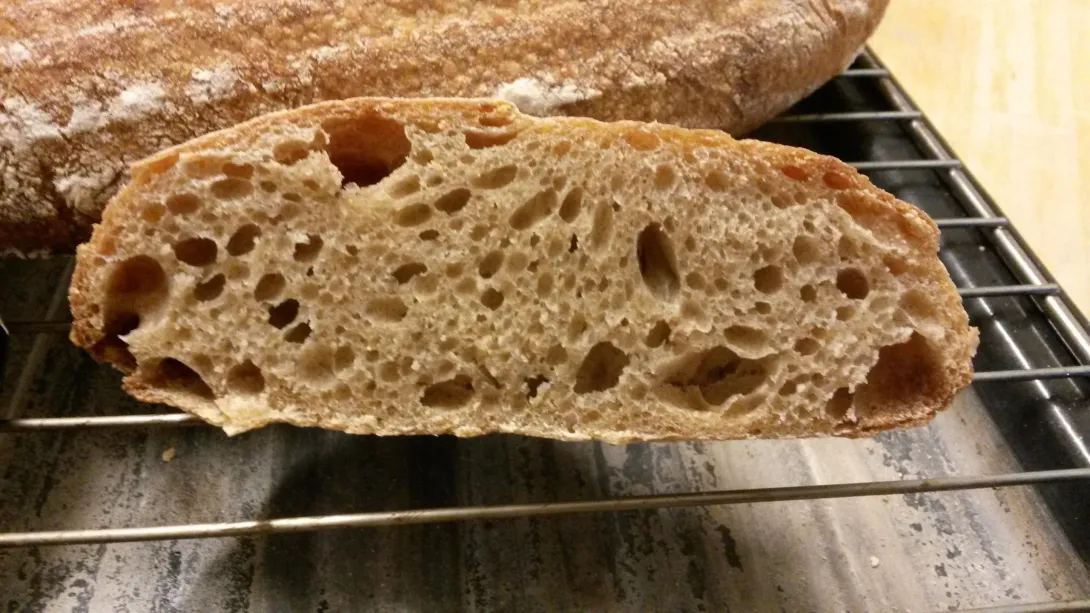
With inspiration from Mini Oven and Dabrownman I tried the ''brown paper bag' method to make a starter.
In a nutshell...
- Make a golf sized piece of dough with whole wheat flour
- Place in a brown paper bag submerged in bread flour and keep somewhere warm
- After 5 or so days cut open the hard shell, scoop out the gloop and feed.
Voila you've got a starter. That's the gist of it.
So last Sunday evening i made the piece of dough with Turkey Red flour, placed it inside a small yoghurt pot completely covered in plain flour.
Friday evening I cut the dough open and sure enough there was the gloop. Fed it with the flour it was submerged in and come Saturday morning it had bubbled up.
From Saturday morning till Sunday morning I built up 170g of starter @ 70% hydration and with Turkey Red flour then put together the following recipe...
RECIPE:
Bread flour 300g
Wholegrain Turkey Red flour 100g
Wholegrain Rye flour 40g
Water 330g
Salt 8g
PREFERMENT:
Wholegrain Turkey Red flour 100g
Water 70g
FINAL DOUGH:
Bread flour 300g
Wholegrain Rye flour 40g
Water 260g
Salt 8g
Preferment 170g
The starter is still young and a bit slow. First bread is as expected for a young starter. However it works and it's delicious! Within one week and literally no fuss I've made a starter and baked the first loaf.
Makes one wonder what all the fuss is about.
While baking this loaf gave off a unique oregano aroma. I think it's the Turkey Red. Although up till now I've only detected cinnamon when using this flour. Perhaps it's the starter.
No need to waste flour and "submerge" in flour. Just toss in a few handfuls enough to dust and prevent sticking to the bag. :). Congratulations on doing almost nothing!
Mini
I went from memory. Had read your post a long time ago and have been meaning to try it out for ages. Must have used about 80-100g in total which is a feat in itself when one considers starter recipes like Forkish. And now you tell me even I went overboard :)
An odd kind of satisfaction doing nothing knowing your starter is making itself. I wonder why anyone would do it any other way knowing this way works a treat.
Thank you Mini. What a great experiment it was.
So wonderful. Nice work.
Mini and DaB along w Abe are treasures of this site.
hester
What a far cry it was from when I made my very first starter. I honestly think there are two issues when making one for the first time...
1: too much info out there
2: one doesn't know what they're looking for
The main problem when making a starter is the person making it and not the starter itself. Really it makes itself. With thanks to Mini and DaBs this has been a very interesting and successful "experiment".
I wonder why we don't just recommend this to everyone on this site? Perhaps even a comprehensive post on it and a link on the front page so whoever is starting off has a guide.
That would just start people off and then they can forge ahead w maintaining one. Superb idea. Maybe let Floyd know.
hester
posts outlining this method? I am curious.
http://www.thefreshloaf.com/node/32665/mini-ovens-no-muss-no-fuss-starter-8-days-laater
I think I will but I am going to add a twist to it. I have a bunch of bran that is left over from this Xmas baking bonanza that I am on so I am going to use that. No only to use some of it up but my thinking is that the yeast beasties live on the outside of the berries so there should be a greater concentration on the bran than on the germ or the endosperm. I will use flour though for the “bedding material”. This is going to be interesting!
Danni, the bran should also provide some great nutrients (minerals, vitamins) for the beasties and accelerate the process/make them fat and happy!
I'm gonna try it too--I'm curious to see what kind of flavor it develops since the culture hasn't been refreshed regularly during elaboration. Would this process inform a different way of maintaining the starter as well???
I have gotten really lackadaisical about my starter maintenance. It gets fed whatever I have on hand: bran, locally milled flour, my own home milled flour, or Unbleached flour. Most of the time though, it gets bran because I often have some left over after sifting. It also gets mixed with left over levain like today, and then I threw in some extra bran to thicken up. This time i let it rise a bit before sticking it in the fridge but often I just put it back there. Then it doesn’t get fed for several weeks until it starts getting low again.
Now for levain building, I am a lot more careful. I do weigh the flour/bran and water that I use and usually do a four stage build to get it nice and lively.
Once the starter is established it is maintained like any other starter. It isn't very quick at first but it is viable and will benefit from a few feeds. That is why I built up the preferment slowly in a few stages only going onto the next once I was sure it was ready. Didn't wish to jump into the main dough blindfolded. I'm trying my next bread already.
This certainly challenges the daily feeding style of making a starter. Once I've done a few bakes it'll be added to my ongoing starter. I make starters quite often but only maintain one in which every starter made has eventually found its home. My starter is made up of many different starters and I like to think it keeps it healthy, introduces new little critters and therefore diversity etc.